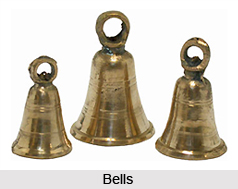 Bells form a category of instruments which are known as percussion instruments. These instruments produce sound on being struck. The common bells in India, also known as Ghanta, are those of indefinite pitch and are struck. Struck bells are those which are employed to cover also the act of striking a bell with a tongue or clapper suspended inside the bell. Though they have not been part of mainstream musical instruments to a significant extent, they continue to be used for worship in homes and temples. As one enters a Hindu temple a row of suspended bells of varying sizes and shapes attract one`s attention; and it is a sign of devotion to first ring them and then enter the sanctum. Bells are generally made of bronze which is, hence, called bell metal. The alloy is of copper (76 percent to 80 percent) and tin (24 percent to 30 percent). But even wooden bells with tongues can be seen in rural areas where they are tied round the necks of cattle.
Bells form a category of instruments which are known as percussion instruments. These instruments produce sound on being struck. The common bells in India, also known as Ghanta, are those of indefinite pitch and are struck. Struck bells are those which are employed to cover also the act of striking a bell with a tongue or clapper suspended inside the bell. Though they have not been part of mainstream musical instruments to a significant extent, they continue to be used for worship in homes and temples. As one enters a Hindu temple a row of suspended bells of varying sizes and shapes attract one`s attention; and it is a sign of devotion to first ring them and then enter the sanctum. Bells are generally made of bronze which is, hence, called bell metal. The alloy is of copper (76 percent to 80 percent) and tin (24 percent to 30 percent). But even wooden bells with tongues can be seen in rural areas where they are tied round the necks of cattle.
Apart from the bells which are struck there is also a class of bells which are shaken. It is probable that shaken bells are prior to the struck ones, for it is reasonable to trace the beginnings of all kinds of bells and instruments of similar nature to dried fruit and shells. Hollow desiccated nuts, fruit and gourd rattling in the wind and making noise could have suggested to forest-dwellers the use of these things for rhythm in dance. The rhythmic sound so provided is indefinite and so is the quality of sound; yet such fruit and shells are easy to obtain. A small Calabash, after being dried, when shaken gives a hazy rhythm. A variation of this is, for instance, the Jhumra of Orissa which is rattled with handle, made of a coconut shell containing pellets or seeds. Instruments and toys of this kind are known throughout India: Jhunjhuni (Bengali), Khunkhuna (Hindi)), Khul-Khula (Marathi), Gilki (Kannada) and so on. The Oraons of Orissa have an instrument called the Kaniyari Danda. It is a long bamboo pole onto which are tied hundreds of dried Champa or Kaniyari fruit. The stick is held vertically and is shaken or beaten on the ground while dancing.
Ankle bells- Ghunghroo (Hindi) Gejjai (Tamil) Gejjalu (Telugu) Gejje (Kannada) are of various shapes: more or less spherical with a free-moving ball of metal inside. The body, more often than not resembles a closed bud, the leaves of the bud being slightly separated. The material used is brass, though ornamental bells are made of silver. More than the musician it is the dancer for whom it is indispensable; indeed, to a dancer in India the ankle bell is almost a totem; and to tie them on ceremoniously is a sign of entry into the profession. Also as decorative waist bands, small bell-lets garlanded are known as Kinkini Jala, Khudra Ghantika, Nupur and so on.
A modification of this principle of bell is not to make a spherical or conical shell or body but a hollow ring. The ring, of brass or bronze, may be completely closed or slit on one side. A few pellets are put into it; the ring is, of course, not necessarily circular. The instrument is known as the Silambu, in Tamil Nadu. When worn on the ankle it is called Karchilambu (kar means leg) and when on the wrist, Kaichilambu (kai means hand). Often, as in the folk-song and dance, Kaichilambu Pattu, the instrument is just held with the hand inserted into it and is moved in a rotatory manner to give the required rhythm. In other parts of south India, as in Mysore, it is known as the Gaggara, whereas north India knows it as Painjan (Painjani) or Nupur.




















